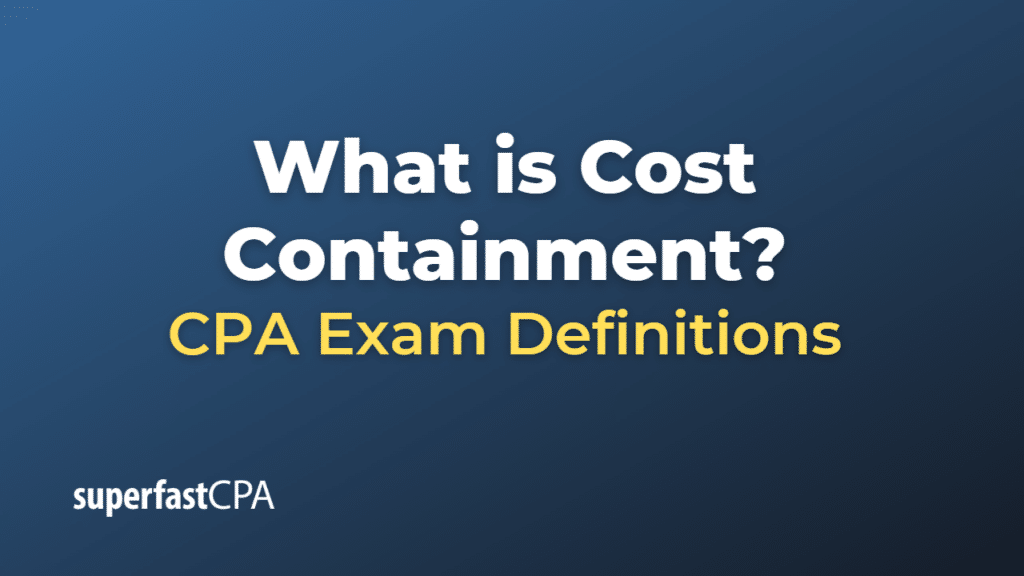Cost Containment
Cost containment refers to the strategies, practices, and measures implemented by organizations to control or reduce their expenses and maintain costs at a manageable level. The main objective of cost containment is to enhance efficiency, improve financial performance, and maximize profitability without compromising the quality of products or services.
Cost containment can be applied to various areas of an organization, such as production, operations, management, marketing, and administration. Some common cost containment strategies include:
- Streamlining processes: Identifying inefficiencies and redundancies in existing processes and implementing more efficient practices to reduce time and resources required for various tasks.
- Negotiating better terms with suppliers: Working with suppliers to negotiate better prices, discounts, or payment terms to lower procurement costs.
- Implementing technology: Leveraging technology to automate repetitive tasks, enhance productivity, and reduce labor costs.
- Reducing waste: Identifying and minimizing waste in the production process, such as reducing material scrap or optimizing energy usage.
- Outsourcing non-core functions: Outsourcing non-essential functions or processes to specialized third-party providers, which may offer cost savings and improved efficiency.
- Implementing cost control measures: Establishing budgets, monitoring expenses, and setting cost targets to ensure that spending remains within predefined limits.
- Training and development: Investing in employee training and development to improve their skills and efficiency, which can lead to cost savings in the long run.
- Re-evaluating product or service offerings: Discontinuing low-margin or underperforming products or services, and focusing on those with higher profitability and growth potential.
Cost containment is essential for organizations to maintain their competitiveness, especially in industries with tight profit margins or rapidly changing market conditions. By effectively managing and controlling costs, companies can enhance their financial performance, optimize resource allocation, and ensure long-term sustainability.
Example of Cost Containment
Let’s consider a fictional small manufacturing company, “EcoBottle Inc.,” which produces eco-friendly, reusable water bottles. In recent months, the company has been facing increasing production costs and declining profit margins. To address these challenges and improve financial performance, EcoBottle decides to implement several cost containment strategies.
- Streamlining processes: EcoBottle reviews its production process and identifies areas where inefficiencies can be reduced. For example, the company modifies the assembly line layout to minimize the movement of workers and materials, saving time and reducing labor costs.
- Negotiating with suppliers: The company renegotiates contracts with its raw material suppliers, securing better prices and volume discounts, which leads to a reduction in material costs.
- Implementing technology: EcoBottle invests in automation technology, such as robotic assembly equipment, to increase production efficiency and reduce labor expenses.
- Reducing waste: The company identifies areas of material waste in the production process and implements measures to minimize scrap, such as optimizing cutting patterns and improving quality control processes.
- Outsourcing non-core functions: EcoBottle outsources its accounting and payroll functions to a specialized service provider, allowing the company to focus on its core manufacturing operations and reduce overhead costs.
- Implementing cost control measures: The company establishes budgets for various departments and monitors expenses closely to ensure that spending stays within predefined limits.
- Training and development: EcoBottle invests in employee training programs, equipping workers with new skills and knowledge to improve efficiency and reduce production errors, leading to cost savings over time.
By implementing these cost containment strategies, EcoBottle Inc. successfully manages to control its expenses, improve its efficiency, and increase its profit margins. This enables the company to maintain its competitiveness in the market, invest in growth opportunities, and ensure its long-term financial sustainability.













